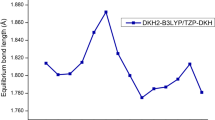Abstract
Quasirelativistic energy-consistent 5f-in-core pseudopotentials modeling divalent (5fn+1 occupation with n = 5–13 for Pu–No) respectively tetravalent (5fn-1 occupation with n = 1–9 for Th–Cf) actinides together with corresponding core-polarization potentials have been generated. Energy-optimized (6s5p4d) and (7s6p5d) valence basis sets as well as 2f1g correlation functions have been derived and contracted to polarized double, triple, and quadruple zeta quality. Corresponding smaller (4s4p) and (5s5p) respectively (4s4p3d) and (5s5p4d) basis sets suitable for calculations on actinide(II) respectively actinide(IV) ions in crystalline solids form subsets of these basis sets designed for calculations on molecules. Results of Hartree–Fock test calculations for actinide di- and tetrafluorides show a satisfactory agreement with calculations using 5f-in-valence pseudopotentials.
Similar content being viewed by others
References
Katz JJ, Seaborg GT and Morss LR (1986). The chemistry of the actinide elements, Vol 2. Chapman and Hall, London
Pepper M and Bursten B (1991). Chem Rev 91: 719
Schreckenbach G, Hay PJ and Martin RL (1999). J Comp Chem 20: 70
Dolg M, Cao X (2003) The relativistic energy-consistent ab initio pseudopotential approach. In: Hirao K, Ishikawa Y (eds) Recent advances in relativistic molecular theory.World Scientific, New Jersey
Cao X and Dolg M (2006). Coord Chem Rev 250: 900
Küchle W, Dolg M, Stoll H and Preuss H (1994). J Chem Phys 100: 7535
Cao X, Dolg M and Stoll H (2003). J Chem Phys 118: 487
Moritz A, Cao X and Dolg M (2007). Theor Chem Acc 117: 473
Cao X, Li Q, Moritz A, Xie Z, Dolg M, Chen X and Fang W (2006). Inorg Chem 45: 3444
Wiebke J, Moritz A, Cao X and Dolg M (2007). Phys Chem Chem Phys 9: 459
Dolg M, Stoll H, Savin A and Preuss H (1989). Theor Chim Acta 75: 173
Dolg M, Stoll H and Preuss H (1989). J Chem Phys 90: 1730
Froese Fischer C (1977) The Hartree–Fock method for atoms. Wiley, New York; program MCHF77, modified for pseudopotentials and quasirelativistic calculations by Dolg M (1995)
Dolg M, Stoll H and Preuss H (1993). Theor Chim Acta 85: 441
Wang Y and Dolg M (1998). Theor Chem Acc 100: 124
Müller W, Flesch J and Meyer W (1984). J Chem Phys 80: 3297
Müller W and Meyer W (1984). J Chem Phys 80: 3311
Kolb D, Johnson WR, Shorer P (1982) Program package to calculate electric and magnetic susceptibilities and shielding factors for closed-shell atoms and ions of high nuclear charge. University of Kassel
Amos RD, Bernhardsson A, Berning A, Celani P, Cooper DL, Deegan MJO, Dobbyn AJ, Eckert F,Hampel C,Hetzer G, Knowles PJ, Korona T, Lindh R, Lloyd AW, McNicholas SJ, Manby FR, Meyer W, Mura ME, Nicklass A, Palmieri P, Pitzer R, Rauhut G, Schütz M, Schuhmann U, Stoll H, Tarroni AJSR, Thorsteinsson T, Werner HJ (2002) MOLPRO is a package of ab initio programs. University of Birmingham
Pitzer RM (1979). Atomic electronic structure code ATMSCF. The Ohio State University, Columbus
Dunning TH (1989). J Chem Phys 90: 1007
Kendall RA, Dunning TH Jr and Harrison RJ (1992). J Chem Phys 96: 6769
Girichev GV, Krasnov KV, Giricheva NI and Krasnova OG (1999). J Struct Chem 40: 207
Konings RJM and Hildenbrand DL (1998). J Alloys Compd 271: 583
Dolg M and Stoll H (1989). Theor Chim Acta 75: 369
Dyall KG, Grant IP, Johnson CT, Parpia FA and Plummer EP (1989). GRASP: atomic structure code. Comput Phys Commun 55: 425
Wang SG and Schwarz WHE (1995). J Phys Chem 99: 11687
Mochizuki Y and Tatewaki H (2003). J Chem Phys 118: 9201
Akdeniz Z, Karaman A and Tosi MP (2001). Z Naturforsch 56: 376
Field RW (1982). Ber Bunsenges Phys Chem 86: 771
Wang Y, Schautz F, Flad HJ and Dolg M (1999). J Phys Chem A 103: 5091
Author information
Authors and Affiliations
Corresponding author
Electronic supplementary material
This file is unfortunately not in the Publisher's archive anymore: 214_2007_330_MOESM1_ESM.pps
This file is unfortunately not in the Publisher's archive anymore: 214_2007_330_MOESM2_ESM.pps
Rights and permissions
About this article
Cite this article
Moritz, A., Cao, X. & Dolg, M. Quasirelativistic energy-consistent 5f-in-core pseudopotentials for divalent and tetravalent actinide elements. Theor Chem Account 118, 845–854 (2007). https://doi.org/10.1007/s00214-007-0330-6
Received:
Accepted:
Published:
Issue Date:
DOI: https://doi.org/10.1007/s00214-007-0330-6




